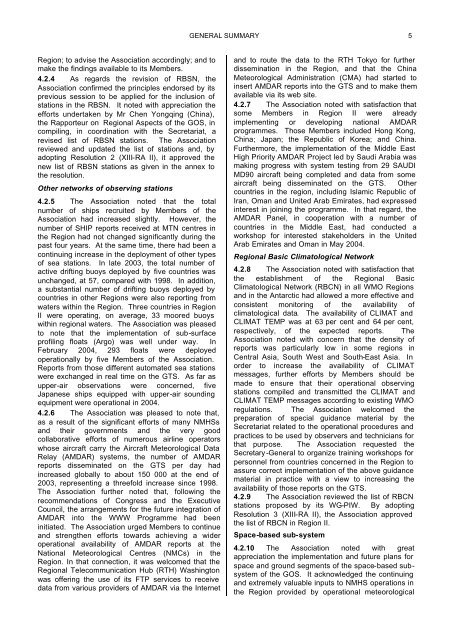Regional Association II (ASIA) - E-Library - WMO
Regional Association II (ASIA) - E-Library - WMO
Regional Association II (ASIA) - E-Library - WMO
You also want an ePaper? Increase the reach of your titles
YUMPU automatically turns print PDFs into web optimized ePapers that Google loves.
GENERAL SUMMARY 5Region; to advise the <strong>Association</strong> accordingly; and tomake the findings available to its Members.4.2.4 As regards the revision of RBSN, the<strong>Association</strong> confirmed the principles endorsed by itsprevious session to be applied for the inclusion ofstations in the RBSN. It noted with appreciation theefforts undertaken by Mr Chen Yongqing (China),the Rapporteur on <strong>Regional</strong> Aspects of the GOS, incompiling, in coordination with the Secretariat, arevised list of RBSN stations. The <strong>Association</strong>reviewed and updated the list of stations and, byadopting Resolution 2 (X<strong>II</strong>I-RA <strong>II</strong>), it approved thenew list of RBSN stations as given in the annex tothe resolution.Other networks of observing stations4.2.5 The <strong>Association</strong> noted that the totalnumber of ships recruited by Members of the<strong>Association</strong> had increased slightly. However, thenumber of SHIP reports received at MTN centres inthe Region had not changed significantly during thepast four years. At the same time, there had been acontinuing increase in the deployment of other typesof sea stations. In late 2003, the total number ofactive drifting buoys deployed by five countries wasunchanged, at 57, compared with 1998. In addition,a substantial number of drifting buoys deployed bycountries in other Regions were also reporting fromwaters within the Region. Three countries in Region<strong>II</strong> were operating, on average, 33 moored buoyswithin regional waters. The <strong>Association</strong> was pleasedto note that the implementation of sub-surfaceprofiling floats (Argo) was well under way. InFebruary 2004, 293 floats were deployedoperationally by five Members of the <strong>Association</strong>.Reports from those different automated sea stationswere exchanged in real time on the GTS. As far asupper-air observations were concerned, fiveJapanese ships equipped with upper-air soundingequipment were operational in 2004.4.2.6 The <strong>Association</strong> was pleased to note that,as a result of the significant efforts of many NMHSsand their governments and the very goodcollaborative efforts of numerous airline operatorswhose aircraft carry the Aircraft Meteorological DataRelay (AMDAR) systems, the number of AMDARreports disseminated on the GTS per day hadincreased globally to about 150 000 at the end of2003, representing a threefold increase since 1998.The <strong>Association</strong> further noted that, following therecommendations of Congress and the ExecutiveCouncil, the arrangements for the future integration ofAMDAR into the WWW Programme had beeninitiated. The <strong>Association</strong> urged Members to continueand strengthen efforts towards achieving a wideroperational availability of AMDAR reports at theNational Meteorological Centres (NMCs) in theRegion. In that connection, it was welcomed that the<strong>Regional</strong> Telecommunication Hub (RTH) Washingtonwas offering the use of its FTP services to receivedata from various providers of AMDAR via the Internetand to route the data to the RTH Tokyo for furtherdissemination in the Region, and that the ChinaMeteorological Administration (CMA) had started toinsert AMDAR reports into the GTS and to make themavailable via its web site.4.2.7 The <strong>Association</strong> noted with satisfaction thatsome Members in Region <strong>II</strong> were alreadyimplementing or developing national AMDARprogrammes. Those Members included Hong Kong,China; Japan; the Republic of Korea; and China.Furthermore, the implementation of the Middle EastHigh Priority AMDAR Project led by Saudi Arabia wasmaking progress with system testing from 29 SAUDIMD90 aircraft being completed and data from someaircraft being disseminated on the GTS. Othercountries in the region, including Islamic Republic ofIran, Oman and United Arab Emirates, had expressedinterest in joining the programme. In that regard, theAMDAR Panel, in cooperation with a number ofcountries in the Middle East, had conducted aworkshop for interested stakeholders in the UnitedArab Emirates and Oman in May 2004.<strong>Regional</strong> Basic Climatological Network4.2.8 The <strong>Association</strong> noted with satisfaction thatthe establishment of the <strong>Regional</strong> BasicClimatological Network (RBCN) in all <strong>WMO</strong> Regionsand in the Antarctic had allowed a more effective andconsistent monitoring of the availability ofclimatological data. The availability of CLIMAT andCLIMAT TEMP was at 63 per cent and 64 per cent,respectively, of the expected reports. The<strong>Association</strong> noted with concern that the density ofreports was particularly low in some regions inCentral Asia, South West and South-East Asia. Inorder to increase the availability of CLIMATmessages, further efforts by Members should bemade to ensure that their operational observingstations compiled and transmitted the CLIMAT andCLIMAT TEMP messages according to existing <strong>WMO</strong>regulations. The <strong>Association</strong> welcomed thepreparation of special guidance material by theSecretariat related to the operational procedures andpractices to be used by observers and technicians forthat purpose. The <strong>Association</strong> requested theSecretary -General to organize training workshops forpersonnel from countries concerned in the Region toassure correct implementation of the above guidancematerial in practice with a view to increasing theavailability of those reports on the GTS.4.2.9 The <strong>Association</strong> reviewed the list of RBCNstations proposed by its WG-PIW. By adoptingResolution 3 (X<strong>II</strong>I-RA <strong>II</strong>), the <strong>Association</strong> approvedthe list of RBCN in Region <strong>II</strong>.Space-based sub-system4.2.10 The <strong>Association</strong> noted with greatappreciation the implementation and future plans forspace and ground segments of the space-based subsystemof the GOS. It acknowledged the continuingand extremely valuable inputs to NMHS operations inthe Region provided by operational meteorological
















